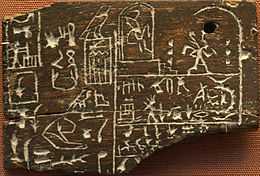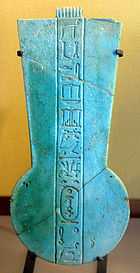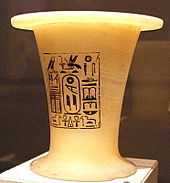Jubilee Pavilion (hieroglyph)
| ||||||||
| Jubilee Pavilion in hieroglyphs |
|---|
The Jubilee Festival[1] for the Pharaoh, the Heb Sed is represented in hieroglyphs by a Jubilee Pavilion Hieroglyph. It is Gardiner Sign Listed as no. O23. However it often appears with other pavilion, or festival hieroglyphs: the Hall, no. O22,
|
|
and an alabaster Basin, no. W3.
|
|
An alternate hieroglyph, the Basin combined with the Hall,
|
|
is represented by Gardiner no. W4. A ligatured combination of the Basin with the Pavilion,
|
|
is shown in some iconographic scenes, (Ramses II, Temple of Amun at Karnak).[2]
The Pavilion hieroglyph
The pavilion hieroglyph is a side view of the pharaoh seated, in opposing views, wearing the two separate crowns, the crown of the South, the white crown, and the crown of the North (the Delta), the red crown. The pavilion is composed of two side views of the naos (hieroglyph), Gardiner no. O18.
|
|

The early Old Kingdom labels, for example Pharaoh Den, portrayed him in a side view in his naos shrine. An example of the combined, opposed, view with the two crowns, is the lintel of Senusret II, 12th dynasty, 19th century BC. It shows the naos curved roofs of each half of the pavilion hieroglyph.
Sed counterpoise amulet

A counterpoise amulet, (menat and counterpoise), for Psammetichus I uses the three separate hieroglyphs for pavilion, hall, and basin. The sequence is hall-above-basin, then pavilion. What follows the three signs is a lizard (hieroglyph), then the Nesu-bity-name-(King of the South, King of the North) in the cartouche of Psammetichus II. (The lizard refers to the "multitudes", (the populace of Ancient Egypt).
The beginning of the text column with the cobra-at-rest-(for speech), then states: "Hb-Sd", determinative-(?) Gard. no. N20,
|
|
The complete text states approximately: "Announce: Heb-Sed, (The)-Multitudes, "Nesu-bity", Psammetichus II."
See also
- Gardiner's Sign List#O. Buildings, Parts of Buildings, etc.
- Sed festival
-

Thutmosis III obelisk
-
Three alabaster basins w/Hall, one basin w/Pavilion
-

Pepi I Heb sed commemorative offering vessel; the right column states: "1st occurrence" S-d(hand), (?), 1-Pavilion, 2-Hall, 3-Festival (3 determinatives); (the "first occurrence" is the Archaic Dagger hieroglyph, and is "tp", (i.e. "top", (=beginning))
References
| Wikimedia Commons has media related to Festival pavilion (hieroglyph). |
- Wilkinson, 1992, Reading Egyptian Art: A Hieroglyphic Guide to Ancient Egyptian Painting and Sculpture, Richard H. Wilkinson, c 1992, 1994, Thames and Hudson; abbreviated Index, 224 pp. (softcover, ISBN 0-500-27751-6)
